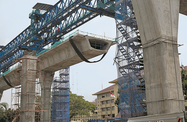A ruling by India’s government last September to end more than a decade of protectionism in the aviation industry is expected to bring new investment to the sector and offer a lifeline to some of its carriers.
While India has played a significant part in the global aviation industry’s growth story, the country’s carriers found themselves struggling in recent years, following the introduction of a government policy in April 2000 barring international airlines from investing in the sector.
The policy remained in place for 12 years, upheld by successive governments, during which time the air transport sector attracted less than $500m in foreign direct investment (FDI), according to the Department of Industrial Policy and Promotion (DIPP). However, with protectionism now lifted, India will be hoping to attract significant support for aviation infrastructure, which is in need of a major overhaul, and cash-strapped domestic airlines.
Inadequate airport infrastructure has led to delays and higher costs for India’s airlines. The investment house ICRA said out last year that intense competition, sharp fluctuations in aviation fuel prices and high debt burdens, together with foreign exchange fluctuations, have all taken their toll on carriers, causing many to suffer losses.
The new rules allowing international airlines to acquire a stake of up to 49% in an Indian carrier will be largely welcomed by operators across the sector, offering some an opportunity to turn their fortunes around.
Jet Airways (JA) became the first local airline to act on the policy reversal, entering into talks with Etihad that could see the Abu Dhabi carrier buy a 24% share in the Indian company. Before its suspension, the local carrier Kingfisher Airlines was also seeking increased foreign investment from Etihad.
Observers suggest the speed with which foreign carriers such as Etihad began talks with local airlines gives an indication of the potential investors see in the market. India’s aviation sector notched up combined annual growth rates of around 16% during the last decade, while the country’s huge population of 1.2bn, together with its pre-set, air travel penetration rate of just 3%, are both major points of interest for investors.
India’s location between Europe and Asia means the country is also well placed to carve out a niche as a hub for international traffic and maintenance, repair and overhaul (MRO), although establishing these services will require a major overhaul of national infrastructure and increased capacity.
The ICRA said foreign investors had also spotted opportunities in listed airlines that were given low-market valuations due to their poor recent performances. India’s six major carriers were hit hard in recent years, not only by rising aviation fuel costs, which doubled in the three-year period from January 2009 to January 2012, but also by the rupee’s continuing depreciation.
Despite the challenges facing the sector, the Centre for Asia Pacific Aviation (CAPA) is bullish on the future of aviation in India, expecting it to become the world’s third-largest market after the US and China by 2020, serving 450m passengers annually. Passenger numbers increased fourfold between 2000-01 and 2011-12 to top 162m.
The CAPA said that based on current growth projections, the six metros area -- located in Bangalore, Chennai, Delhi, Hyderabad, Kolkata and Mumbai -- all required second airports. India’s efforts to expand its catchment could even trigger the need for a third airport in Mumbai, it added.
“Our next focus is on providing air connectivity to remote and interior areas of the country by developing low cost airports and encouraging the growth of regional airlines,” Civil Aviation Minister Ajit Singh said at Aero India 2013 in early February.
The Airports Authority of India (AAI) has identified 35 non-metro and 27 additional airports for upgrades or development, alongside 15 greenfield sites that will be established through public-private-partnerships (PPPs). The CAPA said the projects would require at least $30bn of investment.
Competition remains tough amongst India’s carriers as low-cost carriers (LCCs) continue to increase their market share. Air Asia, for example, is expected to drive forward an aggressive expansion after signing a deal with the Indian conglomerate Tata in February. In contrast, news that banks have moved in to recover their loans from Kingfisher Airlines suggests the former market leader is now beyond saving.
Air India’s opposition to market liberalisation has reinforced the view that the national carrier, which received a taxpayer-funded $5.8bn bailout, is in need of reform. The Civil Aviation Ministry earlier this year lifted a freeze imposed in March 2011 that prevented the overseas expansion of India’s commercial airlines. JA, the national carrier’s main rival, promptly announced increased capacity on domestic and international routes from April 2013.
While the new rules introduced in 2012 were the catalyst for change, the current year should see India’s aviation industry take its first steps along the path to reform, with the expectation of restructuring and, ultimately, a global repositioning for the sector.

